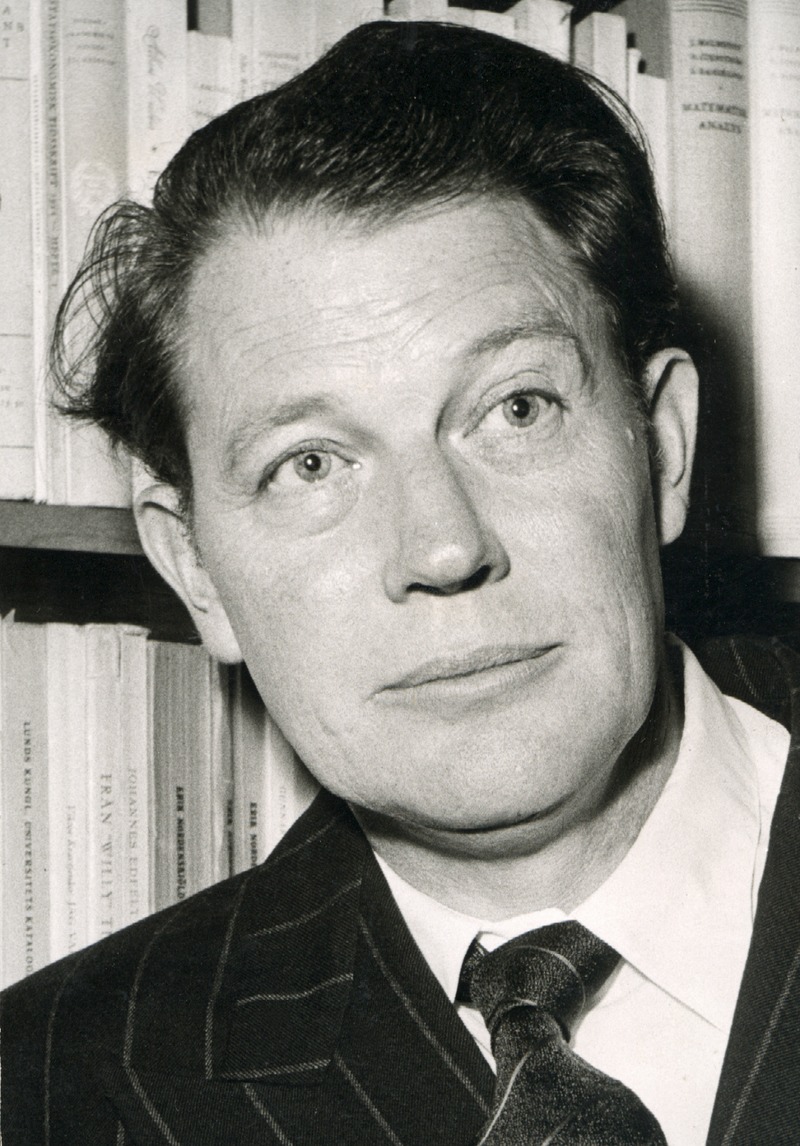20200725
注解: 手指向下或右滑,翻到下一页,向上或左滑,到上一页。
哈瑞·马丁松

简介
哈瑞·马丁松(Harry Martinson,1904-1978)瑞典诗人。生于瑞典南部的卜洛金,5岁丧父,6岁时母亲离家移居美国,他成为各教区轮流收养的孤儿。15岁当海员,随船跑遍南美及印度。此后他漂泊无定,浪迹天涯。马丁松没有受过正规的文化教育和艺术熏陶,他的文学天才是在流浪生涯中生发的,因此被称为“文学界的流浪儿”。1926年,马丁松以海员生涯为题材,发表处女诗集《鬼船》,获得成功。1929年,他和另外四个青年作家合写了一部瑞典文学编年史《五个年轻人》,赢得很大声誉。此后,他发表了大量的诗歌和相当数量的游记、随笔、小说、回忆录等。他的主要诗作有《现代抒情诗选》(1931)、 游牧民族》(1931)、《自然》(1934)、《海风之路》(1945)、《蝉》(1958)、《德由勒之草》(1958)、《车》(196O)、《光与暗之诗》(1971)、《草之山》(1973)等诗集。被公认的代表作是发表于1956年的科幻大空长诗《阿尼亚拉》。马丁松诗作的艺术魁力,不仅表现在想象丰富,联想奇特,语言流畅,感情细腻等方面,而且主要表现在诗人善于采用新的视角观察人生,寻求独到的发现和体悟。因此,他的诗往往具有浓厚的哲理意味和巨大的艺术涵盖力。1949年,马丁松当选为瑞典学院院士。1974年,“由于他的作品能透过一滴露水反映整个世界”,与雍松一起获得诺贝尔文学奖。
He has been called "the great reformer of 20th-century Swedish poetry, the most original of the writers called 'proletarian'."[3]
Life
Martinson was born in Jämshög, Blekinge County in south-eastern Sweden.[4] At a young age he lost both his parents whereafter he was placed as a foster child (Kommunalbarn) in the Swedish countryside.[4] At the age of sixteen Martinson ran away and signed onto a ship to spend the next years sailing around the world visiting countries including Brazil and India.[4]
The headstone on Martinson's grave in Silverdal, Sollentuna – north of Stockholm
A few years later lung problems forced him to set ashore in Sweden[5] where he travelled around without a steady employment, at times living as a vagabond on country roads.[4] At the age of 21, he was arrested for vagrancy in Lundagård park, Lund.[6]
In 1929, he debuted as a poet. Together with Artur Lundkvist, Gustav Sandgren, Erik Asklund and Josef Kjellgren he authored the anthology Fem unga (Five Youths),[7] which introduced Swedish modernism. His poetry, characterized by linguistic innovation and a frequent use of metaphors, combined an acute eye for, and love of nature, with a deeply felt humanism.[8][9] His popular success as a novelist came with the semi-autobiographical Nässlorna blomma (Flowering Nettles) in 1935, about hardships encountered by a young boy in the countryside. It has since been translated into more than thirty languages. The novel Vägen till Klockrike (The Road to Klockrike, 1948) was another huge success, and in 1949 Martinson became the first proletarian writer to be elected a member of the Swedish Academy.[3]
One of his most noted works is the poetic cycle Aniara, which is a story of the spacecraft Aniara that during a journey through space loses its course and subsequently floats on without destination. The book was published in 1956 and became an opera in 1959 composed by Karl-Birger Blomdahl.[10][11] The cycle has been described as "an epic story of man's fragility and folly".[12]
From 1929 to 1940, he was married to Moa Martinson, whom he met through a Stockholm anarchist newspaper, Brand.[3] He travelled to the Soviet Union in 1934.[3][4] He and Moa were divorced due to her criticism of his lack of political commitment.[3] Moa became a writer; Harry married Ingrid Lindcrantz (1916–1994) in 1942.[3][4]
Controversy
The joint selection of Eyvind Johnson and Martinson for the Nobel Prize in 1974[3] was very controversial as both were members of the Swedish Academy and thus on the Nobel panel.[2] Graham Greene, Saul Bellow and Vladimir Nabokov were the favoured candidates that year.[13]
Death
The sensitive Martinson found it hard to cope with the criticism following his award, and committed suicide on 11 February 1978 at the Karolinska University Hospital in Stockholm by cutting his stomach open with a pair of scissors in what has been described as a "hara-kiri-like manner".[14][15]
Legacy
The 100th anniversary of Martinson's birth was celebrated around Sweden in 2004.[16]
Bibliography
Titles in English where known.
Novels
Kap Farväl (Cape Farewell) 1933
Nässlorna blomma (Flowering Nettle) 1935
Vägen ut (The Way Out) 1936
Den förlorade jaguaren (The Lost Jaguar) 1941
Vägen till Klockrike (The Road) 1948
Essays
Resor utan mål (Aimless Journeys) 1932
Svärmare och harkrank 1937
Midsommardalen (Midsommer valley) 1938
Det enkla och det svåra (The easy and the hard) 1938
Verklighet till döds (Reality to death) 1940
Utsikt från en grästuva (Views From A Tuft of Grass) 1963
Poems
Spökskepp 1929
Nomad 1931. Illustrated edition 1943 with new poems and drawings by Torsten Billman
Passad (Trade Wind) 1945
Cikada 1953
Aniara 1956
Gräsen i Thule 1958
Vagnen 1960
Dikter om ljus och mörker 1971
Tuvor 1973
Radio plays
Gringo
Salvation 1947
Lotsen från Moluckas 1948
Stage play
Tre knivar från Wei 1964
Psalms
De blomster som i marken bor
References
"The Nobel Prize in Literature 1974". Nobel Foundation.
Örjan Lindberger "Människan i tiden. Eyvind Johnsons liv och författarskap 1938–1976" Bonniers 1990, pp. 445–447
"Harry Martinson" (in French). Retrieved 27 March 2012.
Holm, Ingvar. "Harry Martinson". Svenskt biografiskt lexikon. National Archives of Sweden.
Sjöberg, Leif (1974). "Harry Martinson: From Vagabond to Space Explorer". Books Abroad. Board of Regents of the University of Oklahoma. 48 (3 (Summer, 1974)): 476–485. doi:10.2307/40128696. JSTOR 40128696.
Westerström, Jenny (6 January 2010). "Den hemlöse i svensk skönlitteratur efter 1900". Lund University. Retrieved 21 December 2015.
Kumm, Björn (12 December 1991). "Obituary: Artur Lundkvist". The Independent. London. p. 13.
"Harry Martinson – Biographical". Nobel Media AB. 2014. Retrieved 4 March 2015.
"Harry Martinson". Albert Bonniers Förlag.
Johansson, Stefan (31 May 2009). "50-åring ur kurs når ännu fram" [50 year old man of course still gets through]. www.svd.se. Svenska Dagbladet. Retrieved 14 February 2014.
Liukkonen, Petri. "Harry Martinson". Books and Writers (kirjasto.sci.fi). Finland: Kuusankoski Public Library. Archived from the original on 9 April 2003.
Critical survey of poetry. American poets. Reisman, Rosemary M. Canfield. (4th. ed.). Pasadena, Calif.: Salem Press. 2011. ISBN 9781587655937. OCLC 712652825.
Shankar, Ravi (12 October 2014). "A Prize With a View". www.newindianexpress.com. The New Indian Express. Retrieved 28 January 2016.
Hansson, Anita (31 August 2000). "Martinson begick harakiri" [Martinson committed hara-kiri]. wwwc.aftonbladet.se. Aftonbladet. Retrieved 21 December 2015.
Gyllensten, Lars (2000). Minnen, bara minnen [Memories, just memories] (in Swedish). Stockholm: Albert Bonniers Förlag. ISBN 91-0-057140-7. SELIBR 7150260.
"Harry Martinson-sällskapets material" [Material from the Harry Martinson Society]. Uppsala University Library.
External links
Wikimedia Commons has media related to Harry Martinson.
Petri Liukkonen. "Harry Martinson". Books and Writers
A translator's look at Flowering Nettles Swedish book review
Harry Martinson on Nobelprize.org